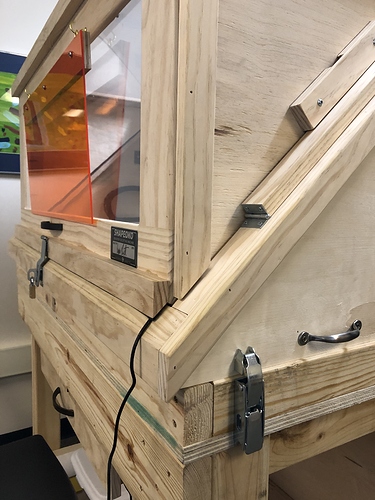I hope that you have at least some ventilation in that cubby. The shopvac WILL get hot and it needs ambient air temperature to keep that motor from overheating. As does the air compressor. Otherwise shortened lives and potential fire hazard. I’d cut some slots in the bottom and maybe a a few holes in the back high. Shouldn’t change the noise.
And please make sure you use eye protection with the j tech laser.
I’m cross posting from a laser forum the comments of a career laser expert.
These little diode lasers are truly dangerous to the eyes.
Dangerous eye destroying multimode rubbish should just about cover it.
Seriously? just don’t… 445nm is likely one of the most dangerous wavelengths available in a compact diode of any kind. It’s fluence and photon energy is huge compared to CO2 and even fibres. While there is no direct comparison between wavelengths (other than a loose watt/seconds) the mechanism of damage that 445 causes makes the injury to the eyes permanent.
Lemme give you a bit of a break down and supporting info
A CO2 @ 10,640nm the photon energy is 0.116 eV
A fibre @ 1064nm the photon energy is 1.165eV
A Blu-ray @ 445nm the photon energy is 2.786eV
So as a “direct” comparison you have 24x as much energy in each photon.
The mechanism of damage is also very different, when a Co2 beam /scatter/reflection hits the eye the damage is done at the surface of the lens, in some cases this can be repairs because the lens can be gotten to by the surgeon, as the wavelength drops the focal transition moves further inside the eye until you get down to the “approaching” UV and UV wavelengths (remember as the wavelength reduces the photon energy increases) once you hit the 445nm range the beam will pass through the lens and is focused by it (that’s how our eyes work on a daily basis) so the final focal point of that energy is the Macula Lutea at the back of the eyeball inside the eye (just in front of the optic nerve).(that’s not getting repaired anytime soon)
Given the very high fluence and photon energy of the 445nm wavelength and the absorption factors of human tissue I have maintained for the last 17 years that 445 and below are wavelengths that should NEVER be available to the general public until LSO’s are on site and Laser Safety procedures are undertaken and fully implemented.
Of all the powerful lasers I have worked with I was more concerned and careful about a 5 watt bench source in 445 than I was about a 7,500 watt CO2…
It appears the j tech has some shielding, but low angle use can make eyes ‘see’ the beam. On wood there should be no reflections, but any metal can. And I do see you have somewhat of a shield. Just be careful

